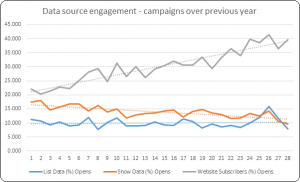
If your organization wants to improve the fit of your hires, reduce the cost of bad hires, and have more candidates say “yes” to your offers, then this article is for you. Did you know that one-third of new hires fail within the first six months? According to a survey by Leadership IQ – 82% of managers say that in hindsight, their interview process elicited subtle clues. Clues that they were heading for trouble. But during the job interview, managers were too focused on other issues or too pressed for time. They didn’t know what to look for, or they lacked confidence in their interviewing abilities to heed the warning signs.
Here is a 3-step process to implement an interviewing for fit methodology in your organization:
Step 1: Structured interviews are more reliable than unstructured interviews.
Research indicates that structured, panel interviews have a higher mean predictive validity than other selection methods. When organized properly, panel interviews are a great tool for saving time and avoiding hiring mistakes. In fact, a panel interview alone can improve hiring accuracy by up to 30%.
Do you remember the show “Who wants to be a millionaire?”? On the show, when stumped, a contestant could use a “lifeline”. They could either call an expert (selected in advance, usually the smartest person the contestant knows) or poll the studio audience. Calling an expert was good, producing the right answer about 65% of the time. But polling the studio audience yielded the right answer 91% of the time! If we can avoid “group thinking” – the decision made by a group is consistently more reliable.
An added benefit is that panel interviews can enhance organizational culture – when a team makes a consensual decision, the whole team is invested in that employee’s success. But poorly organized panel interviews are a waste of time, if there is not a set cadence to the question process with a natural progression then it can feel like a firing squad from the client experience.
How many interviewers on the panel?
Depends on the level of the position. Junior to intermediate roles, 2-3. Executive roles it’s completely okay to have 5 or 6.
Who is on the panel? Typically the hiring team (the direct supervisor, any dotted line supervisors, and maybe one level up for more senior roles). But consider a 360 panel. I’ve seen this work quite well, 360 means potential future employees of the new hire, teammates, and supervisors. I appreciate both the diversity of the perspectives you’ll get, as well as the engagement. “I get to help pick my own boss? They care what I think? Wow, that’s cool!”

Step 2: The power of competency based interviewing.
Competency based interviewing is also known as behavioral interviewing, is predicated on the premise that past performance is the best predictor of future performance. During behavioral interviews, you extract specific examples of what the candidate has done in the past, not what they tell you they will do in the future.
What are competencies? KSAO’s – Knowledge, Skills, Abilities and Other traits that enable one to be successful in a job. What does outstanding performance look like? We are not talking about just technical competencies, like how to code, or how to do an account reconciliation. Leadership IQ conducted a 3-year study of over 20,000 hires in both public and private businesses. Research out of that study depicted the top 5 reasons why new hires fail, and 4 of those 5 are not technical based competencies.
The top five reasons that led to new hire turnover are as follows:
Coachability (26%): The ability to accept and implement feedback from bosses, colleagues, customers and other stakeholders
Emotional Intelligence (23%): The ability to understand and manage their emotions, and accurately assess the emotions of others.
Motivation (17%): Do they have the drive to achieve their full potential and excel in the job.
Temperament (15%): Attitude and personality suited to the job and work environment.
Technical Competence (11%): Functional or technical skills required to do the job.
Hiring failures can be prevented if managers focus more of their interviewing attention to a candidate’s coachability, emotional intelligence, motivation, and temperament. Technical competence remains the most popular subject of interviews because it’s easy to assess. But while technical skill is easy to evaluate, it’s a lousy predictor of whether a new hire will succeed or fail. Because usually success or failure is a matter of fit – does your company foster an environment that this person will thrive in?
How does your interview process assess coachability, EI, motivation, and temperament?

Step 3 Candidate experience is everything.
You’ve heard about “candidate experience”, but what does it mean and why is it so important?
We can liken this to the customer experience. People talk. And in today’s social world, people tweet, post, blog and it goes VIRAL! 95% of customers will tell others about a bad experience. And the same is true of the candidate.
And the damage isn’t limited to your employer brand – your product brand can take a hit too. Consider this interesting statistic – 32% of talent say they would be less likely to buy a product from a company who did not respond to their job application. But you can make this work for you as well. It’s truly an opportunity if you can manage the candidate experience end to end. Open communication with candidates is the top driver of a positive experience. Have you ever applied for a job and felt like your resume was sent into an abyss? A simple, thoughtful response to those who are not a fit goes a long way and not the cold canned responses that come preconfigured in your applicant tracking system.
Your interview process is the initial touch point for candidates to get a sense of your company culture, how you communicate, and how professional you handle yourself, so treat the time with the respect it deserves.
Business & Finance Articles on Business 2 Community(37)





